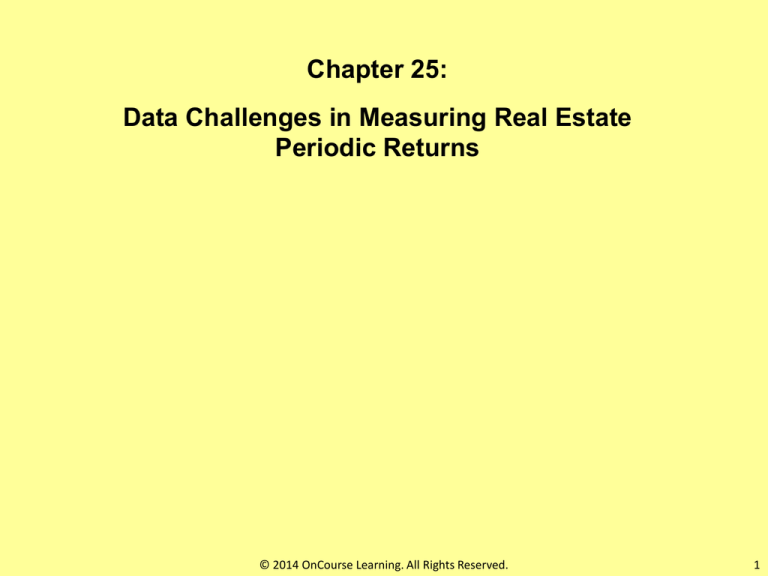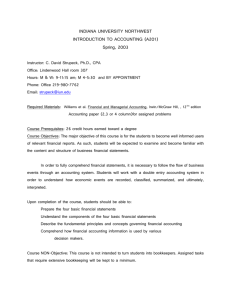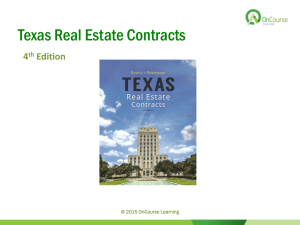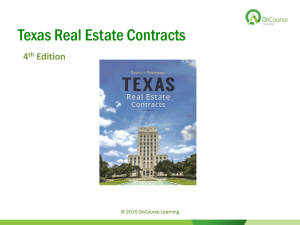
Chapter 25:
Data Challenges in Measuring Real Estate
Periodic Returns
© 2014 OnCourse Learning. All Rights Reserved.
1
Three Major Types/Sources of Indices of Commercial Property
Asset Prices & Investment Performance in the U.S…
Index Type:
Appraisal-based
Source
Examples
• Based on professional
appraisals of individual
properties
• Typically self-reported by
ERISA investmt mgrs
• NCREIF Property Index
(NPI)
• Investment Property
Databank (IPD)
Transactions-based
• Based on actual prices of
traded properties in private
asset mkt
• Need to control for
“apples vs oranges”
problem different assets
traded each period, as by
repeat-sales indices
• Moody’s/RCA CPPI
• RCA CPPI
• CoStar Commercial
Repeat-Sales Index (CCRSI)
Stock Mkt-based
• REIT share price data, delevered & filtered to
represent “pure” property
mkt segments
• FTSE-NAREIT
PureProperty® Index
© 2014 OnCourse Learning. All Rights Reserved.
2
Section 25.1
“Macro-level Valuation”:
Valuing aggregates of many properties at once (e.g.,
portfolios, indexes, entities like REITs or partnerships).
Most basic macro-level valuation problem is valuing static
portfolios…
© 2014 OnCourse Learning. All Rights Reserved.
3
“Static Portfolio”:
A portfolio consisting of a constant fixed set of properties
(the same properties over time).
“Static Portfolio Valuation”:
The value of the portfolio is the sum of the values of all the
individual properties in the portfolio (i.e., simple crosssectional aggregation of values, across the properties in
the portfolio).
Sounds simple: we know how to value individual
properties (Chs.10-12), and we know how to add…
But in fact some additional considerations become
important at the macro-level.
© 2014 OnCourse Learning. All Rights Reserved.
4
Most fundamentally, you must understand:
The trade-off that exists between:
VALUATION PRECISION
(minimizing random error)
VS.
VALUATION “CURRENTNESS”
(minimizing temporal lag bias)
To begin, let’s go back to some basics at the micro-level of
individual property valuation…
© 2014 OnCourse Learning. All Rights Reserved.
5
Brief digression (fundamental background) back to…
Chapter 12 Appendix:
Noise & Values in Private R.E. Asset Mkts:
Basic Valuation Theory…
Understand the difference between:
• Inherent Value
• Investment Value
• Market Value
• Reservation Price
• Transaction Price.
© 2014 OnCourse Learning. All Rights Reserved.
6
Inherent Value: Maximum value a given user would be willing (and able)
to pay for the subject property, if they had to pay that much for it (or, for a
user who already owns the property, the minimum they would be willing to
sell it for), in the absence of any consideration of the market value
(“exchange value”) of the property. – Based on usage value of the property.
Investment Value: Inherent value for a non-user owner (a “landlord”),
i.e., for an investor.
Market Value: Most likely or expected sale price of the subject property
(mean of the ex ante transaction price probability distribution).
Reservation Price: Price at which a market participant will stop
searching and stop negotiating for a better deal and will close the
transaction.
Transaction Price: Actual price at which the property trades in a given
transaction.
Only the last of these is directly empirically observable.
© 2014 OnCourse Learning. All Rights Reserved.
7
Consider a certain type of property…
• There are many individual properties, examples of the type,
• With many different owners.
• Because the owners are heterogeneous, there will be a wide dispersion of
“inherent values” that the owners place on the properties (e.g., like
“investment value” ) because IV differs across investors.
• We can represent this dispersion by a frequency distribution over the
inherent values. . .
Number of agents
Ow ner Inherent Value Frequency Distributions
(as of a single point in time)
Owners
Value ($/SF)
Ow ners
© 2014 OnCourse Learning. All Rights Reserved.
8
Consider a certain type of property…
• There are also many non-owners of this type of property,
• Potential investors.
• Because these non-owners are also heterogeneous, there will be a wide
dispersion of their IV values for this type of property as well.
• Another frequency distribution over the inherent values . . .
Number of agents
Non-ow ner Inherent Value Frequency Distributions
(as of a single point in time)
Non-owners
Value ($/SF)
Non-ow ners
© 2014 OnCourse Learning. All Rights Reserved.
9
Consider a certain type of property…
• There will usually be overlap between the two distributions. . .
Number of agents
Ow ner & Non-ow ner Inherent Value Frequency Distributions
(as of a single point in time)
Non-owners
Owners
Value ($/SF)
Ow ners
Non-ow ners
• It makes sense for the owners’ distribution to be centered to the right
of the non-owners’ distribution, because of past selection:
• Those who have placed higher values on the type of property in question
are more likely to already own some of it.
© 2014 OnCourse Learning. All Rights Reserved.
10
Because there is overlap, there is scope for trading of assets.
(Recall from Ch.7 how investor heterogeneity underlies the investment industry.)
Number of agents
Ow ner & Non-ow ner Inherent Value Frequency Distributions
(as of a single point in time)
Non-owners
Owners
Value ($/SF)
Ow ners
Non-ow ners
There is a mutual benefit from some non-owners whose IV values exceed
those of some owners getting together and trading:
• A price (P) can be found such that:
IV(owner) < P < IV(non-owner).
NPVIV(non-owner) = IV(non-owner) – P > 0
NPVIV(owner) = P - IV(owner) > 0
© 2014 OnCourse Learning. All Rights Reserved.
11
Because there is overlap, there is scope for trading of assets.
Number of agents
Ow ner & Non-ow ner Inherent Value Frequency Distributions
(as of a single point in time)
Non-owners
Owners
Value ($/SF)
Ow ners
Non-ow ners
The number of non-owners willing to trade equals the area under the nonowner distribution to the right of the trading price.
The number of owners willing to trade equals the area under the owner
distribution to the left of the trading price.
If permitted in the society, a real estate asset market will form and begin
operation . . .
© 2014 OnCourse Learning. All Rights Reserved.
12
Number of agents
Ow ner & Non-ow ner Inherent Value Frequency Distributions
(as of a single point in time)
Non-owners
Inherent values tend to be widely
dispersed, reflecting investor
heterogeneity.
Owners
Value ($/SF)
Ow ners
Non-ow ners
Number of agents
Buyers & Sellers Reservation Price Frequency Distributions
(as of a single point in time)
Buyers
(Demand)
Sellers
(Supply)
MV
Value ($/SF)
Sellers
Buyers
The operation of the asset mkt
creates “price discovery” &
“information aggregation”, which
causes agents’ “reservation
prices” (the price at which they
will stop searching or negotiating
and trade) to collapse around the
midpoint of the overlap, the “mkt
clearing price” (MV). (Less
interested owners & non-owners
effectively drop out of the
distributions.)
13
Inherent Values
Number of agents
Ow ner & Non-ow ner Inherent Value Frequency Distributions
(as of a single point in time)
Non-owners
Owners
Value ($/SF)
Ow ners
Non-ow ners
© 2014 OnCourse Learning. All Rights Reserved.
14
Reservation Prices
Number of agents
Buyers & Sellers Reservation Price Frequency Distributions
(as of a single point in time)
Buyers
(Demand)
Sellers
(Supply)
MV
Value ($/SF)
Sellers
© 2014 OnCourse Learning. All Rights Reserved.
Buyers
15
Reservation Prices
Number of agents
Buyers & Sellers Reservation Price Frequency Distributions
(as of a single point in time)
Buyers
(Demand)
Sellers
(Supply)
MV
Value ($/SF)
Sellers
Buyers
Reservation Prices are influenced not only by agents’ inherent values and
perceptions of the market value, but also by agents’ search costs and
degree of certainty about their value perceptions.
© 2014 OnCourse Learning. All Rights Reserved.
16
Number of agents
Buyers & Sellers Reservation Price Frequency Distributions
(as of a single point in time)
Buyers
(Demand)
Sellers
(Supply)
MV
Value ($/SF)
Sellers
Buyers
Market Value equals market clearing price, at which number of
buyers (to right of price under buyer distribution) . . .
© 2014 OnCourse Learning. All Rights Reserved.
17
Number of agents
Buyers & Sellers Reservation Price Frequency Distributions
(as of a single point in time)
Buyers
(Demand)
Sellers
(Supply)
MV
Value ($/SF)
Sellers
Buyers
Market Value equals market clearing price, at which number of
buyers (to right of price under buyer distribution) equals number of
sellers (to left of price under seller distribution).
© 2014 OnCourse Learning. All Rights Reserved.
18
The more “informationally efficient” is the asset market, the more effective is
the price discovery and the information aggregation.
The market learns from itself (about the value of the type of asset being
traded in the market).
In the extreme, the distributions on both sides of the market (the buyers and
the sellers) will collapse onto the single, market-clearing price, at which the
number of buyers equals the number of sellers:
Number of agents
Buyers & Sellers Reservation Price Frequency Distributions
(as of a single point in time)
Buyers
(Demand)
Sellers
(Supply)
P
Value ($/SF)
Sellers
Buyers
Hence, observed prices exactly equal market values.
This is approximately what happens in the stock market.
© 2014 OnCourse Learning. All Rights Reserved.
19
Real estate markets are not that informationally efficient.
There is price dispersion.
Probability
Possible Transaction Price Probability Distribution
The mean of this
distribution
(“expected price”)
is the market
value (MV)
MV
Prices
Observed transaction prices are distributed around the market value.
© 2014 OnCourse Learning. All Rights Reserved.
20
It is impossible to know exactly what is the market value of any property at
any point in time. Observed prices are “noisy” indications of value.
MV can be estimated by observing the distribution of transaction prices, using
statistical or appraisal techniques.
Possible Transaction Price Probability Distribution
MV can be estimated
more accurately:
Probability
• The larger the
number of
transactions (more
frequent trading,
“denser market”), &
MV
Prices
• The more
homogeneous the
assets traded in the
mkt.
• Nevertheless . . .
All estimates of MV (whether appraisal or statistical) contain “error”.
© 2014 OnCourse Learning. All Rights Reserved.
21
Technical Issues in R.E. Indexes
Index return in period t :
Vt Vt 1
rt
Vt 1
Two Issues:
• “Noise” Index value level Vt randomly dispersed
around true population value (Pt):
Vt = Pt ± ~t
• “Lag”, Index value level Vt tends to be a blend of
current and recent past population values, e.g.:
Vt = (1/2)Pt + (1/2)Pt-L.
25.1.3
The NOISE vs. LAG TRADE-OFF
Example:
You own a property. Would you rather have an estimate of
value that is accurate to within 10% with no lag bias, or to
within 2% but whose most likely value is what the property
was worth 6 months ago?…
Your answer probably depends on how you are going to use the appraisal:
• Are you just interested in the value of that one property?
• Or will you be combining that property’s valuation with many others to arrive at
the value of an entire portfolio or index?
In the latter case, the purely random error in the property valuation
estimate will tend to cancel out with other errors and diversify away, but the
temporal lag bias will not go away.
© 2014 OnCourse Learning. All Rights Reserved.
23
25-3 Noise-vs-Lag Trade-off Frontiers with Disaggregate and Aggregate Valuation Methodologies
Lag Bias
0 mos
TAgg
“Corner Solution”
Optimum @ Zero Lag.
C
UAgg
TDis
TAgg
6 mos
A
B
TDis
15%
8%
UDis
2%
0%
Random Error (σε )
Reduced Random Error
© 2014 OnCourse Learning. All Rights Reserved.
24
The Noise vs Lag Trade-off (Sect. 25.1.3) . . .
•To reduce random estimation error, more
empirical value observations (transactions data)
are required.
• To obtain more empirical value obs,
transactions must be taken from a longer span of
history (reaching further back in time).
• The “Square Root of N Rule” provides
diminishing returns in this process (a concave
trade-off frontier).
Reduced random noise
© 2014 OnCourse Learning. All Rights Reserved.
25
The Noise vs Lag Trade-off . . .
• This is the trade-off at the disaggregate
(individual property) level.
• This is the level that is relevant
for appraisal valuations.
Reduced random noise
© 2014 OnCourse Learning. All Rights Reserved.
26
The Noise vs Lag Trade-off . . .
• Property value estimates are made for users of this information.
• These users dislike both random estimation error and temporal lag
bias, but logically:
• with diminishing marginal utility for both types of
accuracy (see U0 indiff.curve).
• Point A is a typical optimal individual property
value estimation (an appraisal maximizing the
client’s utility of the appraisal).
A
• It has a certain amount of random error and a
certain amount of temporal lag bias.
U0
Reduced random noise
© 2014 OnCourse Learning. All Rights Reserved.
27
25.1.4: Noise-vs-Lag Trade-off Frontiers with Disaggregate (Traditional Appraisal)
and Aggregate (Transactions Based Regression) Valuation Methodologies
NA = Disaggregate (Appraisal) Optimal Sample Size (# comps) = nA(LA+1), nA = comps density/period;
NC = Aggregate (Transactions Based Regression) Optimal Sample Size (obs per period);
Q = Number of Market Segments in the Index Population (as multiple of number used by appraiser).
Lag Bias
in Periods
Exh. 25-3
“Corner Solution” Optimum
@ Zero Lag. Transactions
Based Index
C
0
TAgg
TDis
LA /2
A
B
U1
TAgg
TDis
U0
1/NA
1/NC
1/(QNA)
0
Random Error (fraction of σε2 )
Reduced random error
© 2014 OnCourse Learning. All Rights Reserved.
28
Noise-vs-Lag Trade-off Frontiers with Disaggregate (Traditional Appraisal) and
Aggregate (Transactions Based Regression) Valuation Methodologies
NA = Disaggregate (Appraisal) Optimal Sample Size (# comps) = nA(LA+1), nA = comps density/period;
NC = Aggregate (Transactions Based Regression) Optimal Sample Size (obs per period);
Q = Number of Market Segments in the Index Population (as multiple of number used by appraiser).
Lag Bias
in Periods
Exh. 25-3
“Corner Solution” Optimum
@ Zero Lag. Transactions
Based Index
C
0
C: Index is optimized at aggregate
level.
TAgg
TDis
B: Index is aggregation of optimal
individual appraisals.
LA
A
B
U1
TAgg
TDis
U0
1/NA
1/NC
1/(QNA)
0
Random Error (fraction of σε2 )
Reduced random error
© 2014 OnCourse Learning. All Rights Reserved.
29
Section 25.2
II. Problems in real estate periodic returns data…(25.2)
Background: From values to returns…
Recall the definition of the periodic return:
Vt Vt 1 CFt Vt Vt 1 CFt
rt
g t yt
Vt 1
Vt 1
Vt 1
We need:
Vt = True value of asset as of the end of period “t” in
time.
Vt-1 = True value of asset as of the end of period “t-1” in
time.
OK for publicly-traded securities (at quarterly frequency).
But for private real estate, “we have a problem”…
© 2014 OnCourse Learning. All Rights Reserved.
30
In fact, we have two problems:
Observed value of Vt is measured with random error,
exhibits “noise”.
Observed value of Vt exhibits “temporal lag bias”, as
if computed from a trailing moving average across time.
© 2014 OnCourse Learning. All Rights Reserved.
31
Here is a picture of the typical pure effect of noise (alone)
on an index of cumulative asset or portfolio value levels:
Exh.25-4B
1.4
1.3
1.2
1.1
1.0
True
Noisy
0.9
0.8
0.7
0.6
0.5
1
11
21
31
41
TIME
How does this “sawtooth” effect result from random noise? . . .
© 2014 OnCourse Learning. All Rights Reserved.
32
Aside: How does this “sawtooth” effect result from random
noise? . . .
Value
Suppose this is the true (unobservable) history of real estate
values over time:
And suppose valuation error equals +10% or -10%, randomly
over time (independent errors), as if from the flips of a coin…
© 2014 OnCourse Learning. All Rights Reserved.
Time
33
Random valuation error adds excess apparent volatility,
that is transient (“mean-reverts”) over time:
Exh.25-4B
1.4
1.3
1.2
1.1
1.0
True
Noisy
0.9
0.8
0.7
0.6
0.5
1
11
21
31
41
TIME
© 2014 OnCourse Learning. All Rights Reserved.
34
Here is a picture of the typical pure effect of temporal lag
bias (alone) on an index of cumulative asset or portfolio
value levels:
Exh.25-5B
1.4
1.3
1.2
1.1
1.0
True
Lagged
0.9
0.8
0.7
0.6
0.5
1
11
21
31
41
TIME
How does this lag effect result from historical temporal aggregation?
© 2014 OnCourse Learning. All Rights Reserved.
35
Aside: How does the lag effect result from historical temporal
aggregation? . . .
Value
Suppose this is the true (unobservable) history of real estate
values over time:
Time
And suppose appraisers use two comps which they weight equally to estimate the current
period’s value, one comp is current, the other from the previous period (& ignore random
error to focus on the pure temporal aggregation effect).
© 2014 OnCourse Learning. All Rights Reserved.
36
Temporal aggregation results in an apparent index that is
both lagged and smoothed (less volatile) compared to the
true values:
Exh.25-5B
1.4
1.3
1.2
1.1
1.0
True
Lagged
0.9
0.8
0.7
0.6
0.5
1
11
21
31
41
TIME
© 2014 OnCourse Learning. All Rights Reserved.
37
Here is a picture of the typical appraisal-based index, which
includes both random noise & temporal lag:
Exh.25-6B
1.4
1.3
1.2
1.1
1.0
True
Appraised
0.9
0.8
0.7
0.6
0.5
1
11
21
31
41
TIME
How much of each type of error depends on how many properties (appraisals) are
included in the portfolio or index, and on how much lagging the appraisers had to do at
the individual property (disaggregate) valuation level.
© 2014 OnCourse Learning. All Rights Reserved.
38
The two pure effects and appraisals . . .
Exh.25-6B
1.4
1.3
1.2
1.1
True
1.0
Noisy
Lagged
0.9
Appraised
0.8
0.7
0.6
0.5
1
11
21
31
41
TIME
Of course, the “true” value index would be unobservable in the real world.
© 2014 OnCourse Learning. All Rights Reserved.
39
These types of valuation errors can cause a number of problems:
· “Apples vs oranges” comparison betw R.E. and
securities returns
· Misleading estimates of R.E. ex post investment
performance
· Misleading estimates of R.E. risk and co-movement:
· (e.g., R.E. covariance or is underestimated.)
· Out-of-date information about property mkts:
· (e.g, have mkts “peaked”, or are they still “rising”?)
How to understand, recognise, and deal with the returns data
problem (Ch.25)…
© 2014 OnCourse Learning. All Rights Reserved.
40
Section 25.3
25.3. What is Truth? Lags and the Timeline of Price
Discovery in Real Estate
Suppose publicly-observable “news” arrives at a point “t” in time.
This news is relevant to the value of real estate assets. What will
happen?
1st) REIT share prices quickly and fully respond to the news,
changing to the newly appropriate level almost immediately
(probably within a day or two). We can represent this as:
V*REITt = VREITt
V*REITt = Observed REIT value, as of end of period “t”.
VREITt = True REIT value, as of end of period “t”.
(Maybe a little “overreaction”, then correction?…)
(Maybe some “spurious” movements: things REIT investors care about that
property investors don’t care about?…)
(But at least they move quickly and in the right direction in response to relevant
news.)
© 2014 OnCourse Learning. All Rights Reserved.
41
2nd) Property market liquid asset values respond more gradually to
the news:
Vt = 0 VREITt + 1 VREITt-1 + . . . , where 0<t<1, and t=1
Vt = Property market value (“liquid” value, “bid price”) as of
end of “t”.
VREITt = Full-information value (as if it were a REIT) in that same
market.
Note: Vt VTt . . .
Transaction prices (VTt)observed in the property asset market at time
“t” are not generally the same as fully liquid market prices (especially
in a down-market). This is because liquidity is in fact not constant
across time in property markets, as many property owners do not
require constant liquidity in their real estate holdings, so they tend to
hold properties off the market during “down markets” and to sell more
properties during “up markets”.
© 2014 OnCourse Learning. All Rights Reserved.
42
Here is what pro-cyclical variable liquidity
looks like in the NCREIF Index:
NCREIF Prices & Turnover Ratios, 1984-2001
0.2
20%
15%
0
84 85 86 87 88 89 90 91 92 93 94 95 96 97 98 99 00 01
-0.1
10%
-0.2
-0.3
5%
Percent Properties Sold
Log Price Level
0.1
-0.4
-0.5
0%
Year
© 2014 OnCourse Learning. All Rights Reserved.
43
3rd) Empirically observable transaction prices in the property
market will even more gradually reflect the news (at least during
down-markets, when prices are falling):
Vt 0Vt 1Vt 1 2Vt 2 ,
where:
period t.
1
Vt
= Cross-sectnl avg transaction price in period t;
Vt
= Cross-sectnl avg liquid value (bid price) in
© 2014 OnCourse Learning. All Rights Reserved.
44
4th) Appraised values of properties will respond even more
gradually (Appraisers tending to be more “backward-looking”,
dependent on transaction price observations, than property
market participants who make or lose money depending on how
well they can be “forward-looking”.)
We can represent this as:
V *t Vt (1 )V *t 1
0<a<1,
a = "Confidence Factor",
(1-)=Smoothing factor.
where V*t is property appraised value as of the end of quarter "t"
and Vt is the average empirically observable transaction price
during quarter “t”.
© 2014 OnCourse Learning. All Rights Reserved.
45
5th) Indexes of appraisal-based returns may respond even more
slowly to the news, if all properties in the index are not
reappraised every period, yet they are included in the index at
their last appraised valuation.
Problem of “stale” valuations in the index, e.g.:
V**t = (¼)V*t + (¼)V*t-1 + (¼)V*t-2 + (¼)V*t-3
where V**t is the index value in quarter t.
If more of the properties are reappraised in the fourth calendar quarter (as
with the NCREIF Index), then something like the following model might
well represent the index in the 4th quarter of every year:
V**t = (1/2)V*t + (1/6)V*t-1 + (1/6)V*t-2 + (1/6)V*t-3
This will make the index more “up-to-date” at the end of the 4th quarters
than it is in the other quarters, and it will impart “seasonality” into the
quarterly index returns.
© 2014 OnCourse Learning. All Rights Reserved.
46
25.3.1
Here is a schematic picture of how this time-line of price
discovery might play out in response to the arrival of a
single piece of (bad) news…
Exhibit 25-7
100
1
2
3
4
5
90
1 = REIT Index
2 = Liquid Property Value
3 = Empirical Transactions
4 = Appraised Values
5 = Staggered Appraisal Index
(NCREIF)
t
© 2014 OnCourse Learning. All Rights Reserved.
Time
47
Summary of lagged incorporation of “news” into values:
Time
t
News arrives.
REIT
Prices
respond
Property
Mkt Val
Fully
reflects
Appraised
Values
Fully
reflect
© 2014 OnCourse Learning. All Rights Reserved.
Index
Fully
reflects
48
What this looks like in the real world:
The time line of real estate price discovery…
(1)Public (2)Const.Liq (3)Var.Liq. (5)Appraisal:
Four Definitions and Measures of U.S. Commercial Property Values, 2000-2011.
(1) REIT-based: FTSE-NAREIT PureProperty (daily)
(2) Constant-Liquidity: NCREIF NTBI Demand
(3) Trasaction Prices: NCREIF NTBI
(*NTBI Demand index starting value set to equalize average historical price and demand
9/23/2011
1/14/2011
5/7/2010
8/28/2009
12/19/2008
4/11/2008
8/3/2007
11/24/2006
3/17/2006
7/8/2005
10/29/2004
2/20/2004
6/13/2003
10/4/2002
1/25/2002
5/18/2001
(5) Stale-appraisal-based: NPI
9/8/2000
1950
1900
1850
1800
1750
1700
1650
1600
1550
1500
1450
1400
1350
1300
1250
1200
1150
1100
1050
1000
950
900
12/31/1999
1999 Value = 1000*
Exh. 25-8
indices value levels. Horizontal-axis is all weekdays; gaps in data are stock market holidays. )
© 2014 OnCourse Learning. All Rights Reserved.
49
25.4.1: Overview of Different Types of Indices:
Different types of indices have different strengths & weaknesses
Index Type:
Appraisal-based
Strengths
Weaknesses
• Can be available when
others not
• Strong profession &
tradition in some countries
• Opinions not actual prices
• Tend to lag & smooth
market values
• Can be subject to
influence
Transactions-based
• Actual prices directly
reflect mkt equilibrium
• Objective info, less
susceptible to manipulation
• Requires large historical
database
• Statistical models
Stock Mkt-based
• REITs (or property “pure
plays”) traded in many
countries
• Uses information
efficiency & liquidity of
stock mkt
• Leading indicator, daily
updates
• Some countries have few
REITs, or short history, or
thin market
• Information only indirect
about actual property mkt
Therefore…
© 2014 OnCourse Learning. All Rights Reserved.
50
First: NCREIF Property Index (NPI), since 1982, appraisal-based
(X-axis is all weekdays; gaps in data are stock market holidays.)
Composites are value-weighted.
9/23/2011
1/14/2011
5/7/2010
8/28/2009
12/19/2008
4/11/2008
8/3/2007
11/24/2006
3/17/2006
7/8/2005
10/29/2004
2/20/2004
6/13/2003
10/4/2002
1/25/2002
5/18/2001
NCREIF NPI (appraisal-based)
9/8/2000
2100
2050
2000
1950
1900
1850
1800
1750
1700
1650
1600
1550
1500
1450
1400
1350
1300
1250
1200
1150
1100
1050
1000
950
900
12/31/1999
1999 Value = 1000
U.S. Institutional Commercial Property Composite Capital Value, 2000-2011:
Various types of indices...
Quarterly
Based on small (but important) population (pension funds), law requires regular re-appraisal. (U.S. GAAP does not require appraisals.)
Tracks same-property valuations & total returns. Appraisals lag & smooth market values, but widely accepted & used by industry.
2005: NCREIF-based “TBI”, transaction based
NCREIF NPI (appraisal-based)
(X-axis is all weekdays; gaps in data are stock market holidays.)
Composites are value-weighted.
9/23/2011
1/14/2011
5/7/2010
8/28/2009
12/19/2008
4/11/2008
8/3/2007
11/24/2006
3/17/2006
7/8/2005
10/29/2004
2/20/2004
6/13/2003
10/4/2002
1/25/2002
5/18/2001
NCREIF TBI (transaction based)
9/8/2000
2100
2050
2000
1950
1900
1850
1800
1750
1700
1650
1600
1550
1500
1450
1400
1350
1300
1250
1200
1150
1100
1050
1000
950
900
12/31/1999
1999 Value = 1000
U.S. Institutional Commercial Property Composite Capital Value, 2000-2011:
Various types of indices...
Quarterly
Originally developed at MIT Center for Real Estate, now produced by NCREIF, based on same population as NPI, but transaction prices of sold
properties. “Hedonic price model” approximated by ratio: TBI(t) = (P(t)/A(t))NPI(t).
2006: RCA-based “CPPI”, repeat-sales index (transactions based)
NCREIF NPI (appraisal-based)
NCREIF TBI (transaction based)
(X-axis is all weekdays; gaps in data are stock market holidays.)
Composites are value-weighted.
9/23/2011
1/14/2011
5/7/2010
8/28/2009
4/11/2008
8/3/2007
12/19/2008
Quarterly
11/24/2006
3/17/2006
7/8/2005
10/29/2004
2/20/2004
6/13/2003
10/4/2002
1/25/2002
5/18/2001
Moodys/RCA CPPI
9/8/2000
2100
2050
2000
1950
1900
1850
1800
1750
1700
1650
1600
1550
1500
1450
1400
1350
1300
1250
1200
1150
1100
1050
1000
950
900
12/31/1999
1999 Value = 1000
U.S. Institutional Commercial Property Composite Capital Value, 2000-2011:
Various types of indices...
1st CRE index using repeat-sales methodology. Based on larger population of properties than NCREIF:
Real Capital Analytics (RCA) database of all sales > $2,500,000. Tracks same-property prices (not total returns). Similar method to Case-Shiller.
2012: FTSE-NAREIT PureProperty™ Indices, stock mkt based…
NCREIF NPI (appraisal-based)
NCREIF TBI (transaction based)
Moodys/RCA CPPI
(X-axis is all weekdays; gaps in data are stock market holidays.)
Composites are value-weighted.
9/23/2011
1/14/2011
5/7/2010
8/28/2009
12/19/2008
4/11/2008
8/3/2007
11/24/2006
3/17/2006
7/8/2005
10/29/2004
2/20/2004
6/13/2003
10/4/2002
1/25/2002
5/18/2001
FTSE/NAREIT PureProperty (REIT-based)
9/8/2000
2100
2050
2000
1950
1900
1850
1800
1750
1700
1650
1600
1550
1500
1450
1400
1350
1300
1250
1200
1150
1100
1050
1000
950
900
12/31/1999
1999 Value = 1000
U.S. Institutional Commercial Property Composite Capital Value, 2000-2011:
Various types of indices...
PureProperty Daily, Others Quarterly
Daily-updated index, based on de-geared REIT share prices. REITs are “pure plays” in commercial property. Index statistically infers movements
in underlying property assets implied by movements in REIT share prices. Uses information efficiency and liquidity of stock market.
How repeat-sales price index works… 25.4.2: Repeat-Sales Indices.
Numerical Example of Repeat-Sales Regression Model
True Price Index
True Capital Return
Property # 1
Property # 2
Property # 3
2006
1.00
$100,000
$200,000
No Data
Prices Observed at Ends of Years:
2007
2008
1.00
1.10
0%
10%
No Data
No Data
No Data
$220,000
$300,000
No Data
2009
1.045
-5%
$104,500
No Data
$313,500
1.10
Prop # 2
1.045
Prop # 1
Prop # 3
1.00
1.00
2007
2008
(See posted repeat-sales index simulator Excel file.)
2009
55
How repeat-sales price index works…
Numerical Example of Repeat-Sales Regression Model
Regression model: Y = a2007(X2007) + a2008(X2008) + a2009(X2009)
Y = Log price difference (LN of ratio 2nd sale price / 1st sale price).
Xyr = Dummy variable (= 1 if yr betw 1st & 2nd sales; yr during investr holding).
ayr = Parameters to be estimated = True log price ratio during yr.
RSR Estimation Data
Observation # 1
Observation # 2
Observation # 3
Y value
= LN(Ps/Pf)
LN(1.045)
LN(1.10)
LN(1.045)
X2007 value
1
1
0
X2008 value
1
1
1
X2009 value
1
0
1
Estimation: Solve simultaneous equations (1 eq per obs):
LN(1.045) = a2007(1) + a2008(1) + a2009(1)
LN(1.045) = a2007 + a2008 + a2009 Eq.(1)
LN(1.100) = a2007(1) + a2008(1) + a2009(0)
LN(1.100) = a2007 + a2008
Eq.(2)
LN(1.045) = a2007(0) + a2008(1) + a2009(1)
LN(1.045) =
+ a2008 + a2009 Eq.(3)
Eq.(2) a2008 = LN(1.1) – a2007
Eq.(2&3) a2009 = LN(1.045) – LN(1.1) + a2007
Sub into Eq.(1) LN(1.045) = a2007 + [LN(1.1) – a2007] + [LN(1.045) – LN(1.1) + a2007]
a2007 = 0 = LN(1/1). Sub back into (2)&(3) a2008 = LN(1.1) = LN(1.1/1),
a2009 = LN(1.045/1.1). Exponentiate to retrieve true index price ratios: 1.00, 1.10, 1.045/1.1.
Retrieved returns: 0% (2007), 10% (2008), -5% (2009).
56
How repeat-sales price index works…
Numerical Example of Repeat-Sales Regression Model
Thus, model retrieves true returns (including 2009 negative):
2007
0%
2008
10%
2009
-5%
Even though no single repeat-sale observation reveals any one return,
and none of the investments had a price decline…
1.10
Prop # 2
1.045
Prop # 1
Prop # 3
1.00
1.00
2007
2008
© 2014 OnCourse Learning. All Rights Reserved.
2009
57
How repeat-sales price index works…
Numerical Example of Repeat-Sales Regression Model
Thus, model retrieves true returns (including 2009 negative):
2007
0%
2008
10%
2009
-5%
Even though no single repeat-sale observation reveals any one return,
and none of the investments had a price decline…
This is a general result:
As long as data contains at least one sale (obs) per period,
model can find return in each period.
In real world, there will also be random dispersion of
individual transaction prices around market price.
But there will also be more than one observation per period.
Statistical techniques can optimize the resulting estimates
(e.g., OLS, WLS, ridge, time-wtd dummies).
© 2014 OnCourse Learning. All Rights Reserved.
58
See repeat-sales index simulator Excel file on book’s CD…
1.30
True index
Estd index
1.20
Obs 1 (ratio)
Obs 2 (ratio)
1.10
Obs 3 (ratio)
Obs 4 (ratio)
1.00
Obs 5 (ratio)
Obs 6 (ratio)
Obs 7 (ratio)
0.90
Obs 8 (ratio)
Obs 9 (ratio)
Obs 10 (ratio)
Obs 11 (ratio)
0.80
Obs 12 (ratio)
0.70
2006
2007
2008
2009
© 2014 OnCourse Learning. All Rights Reserved.
59
“Institutional” (aka “Investment Grade”) properties (larger, in primary mkts) exhibit
different price behavior than smaller (“mom & pop”) properties, as seen in CCRSI…
CoStar CCRSI, Investment vs General Commercial Properties:
Exh. 25-9
Same-property (repeat-sales) Prices, 2000-2012
220
CCRSI General Property
210
CCRSI Investment Property
200
190
1999 Value = 100
180
170
160
150
140
130
2001-10:
General
Investment
All
120
110
RS obs
70%
30%
100%
RS $vol
21%
79%
100%
12/1/2011
6/1/2011
12/1/2010
6/1/2010
12/1/2009
6/1/2009
12/1/2008
6/1/2008
12/1/2007
6/1/2007
12/1/2006
6/1/2006
12/1/2005
6/1/2005
12/1/2004
6/1/2004
12/1/2003
6/1/2003
12/1/2002
6/1/2002
12/1/2001
6/1/2001
12/1/2000
6/1/2000
12/1/1999
100
Data source: CoStar Group Inc. Index values as of June 2012.
Reflects different sources of financing (non-bank vs bank), different owner/investor
clienteles (natl/intl instns vs local/users), different asset mkt segments.
Even within the “institutional” properties, there is some asset mkt segmentation…
Exh. 25-10
220
200
“Major” = Bos, NYC, DC, Chi, SF, LA.
“Non-Major” = All else.
180
2000 = 100
Moody's/RCA CPPI, Major & Non-Major Markets Composite Indices:
Same-property Price Evolution (Repeat-Sales)
160
140
120
100
6.2012
12.2011
6.2011
12.2010
6.2010
12.2009
6.2009
12.2008
6.2008
12.2007
6.2007
12.2006
6.2006
Major
12.2005
6.2005
12.2004
6.2004
12.2003
6.2003
12.2002
6.2002
12.2001
6.2001
12.2000
80
Non-Major
Source: Real Capital Analytics. Index histories as of July 2012.
This is all larger properties ($2.5M+), corresponds roughly to CoStar “Investment” properties.
61
Composite Indices:
Value-Weighted
Moody’s/RCA Repeat-Sales Index Scheme, Based on 10 “Buildingblock” segment-specific indices…
All
Apt
Apt
Composite
Indices:
Value-Weighted
Apt
Maj
Apt
Not
Ind
Maj
Com
Ind
Ind
Not
Major
Mkts
OffC
Maj
OffCBD
OffC
Not
OffS
Maj
OffSub
OffS
Not
Ret
Ret
Maj
Ret
Not
NotMaj
Mkts
Two Supplemental Composites Not Integrated Into the Overall Composite Scheme
© 2014 OnCourse Learning. All Rights Reserved.
62
12.2000
3.2001
6.2001
9.2001
12.2001
3.2002
6.2002
9.2002
12.2002
3.2003
6.2003
9.2003
12.2003
3.2004
6.2004
9.2004
12.2004
3.2005
6.2005
9.2005
12.2005
3.2006
6.2006
9.2006
12.2006
3.2007
6.2007
9.2007
12.2007
3.2008
6.2008
9.2008
12.2008
3.2009
6.2009
9.2009
12.2009
3.2010
6.2010
9.2010
12.2010
3.2011
6.2011
9.2011
12.2011
3.2012
Exh. 25-11A
Major Mkts Apt
CPPI Major Markets Building-Block Indices
240
220
200
180
160
140
120
100
80
60
Major Mkts Ind
Major Mkts CBD Off
Major Mkts Sub Off
© 2014 OnCourse Learning. All Rights Reserved.
Major Mkts Ret
63
12.2000
3.2001
6.2001
9.2001
12.2001
3.2002
6.2002
9.2002
12.2002
3.2003
6.2003
9.2003
12.2003
3.2004
6.2004
9.2004
12.2004
3.2005
6.2005
9.2005
12.2005
3.2006
6.2006
9.2006
12.2006
3.2007
6.2007
9.2007
12.2007
3.2008
6.2008
9.2008
12.2008
3.2009
6.2009
9.2009
12.2009
3.2010
6.2010
9.2010
12.2010
3.2011
6.2011
9.2011
12.2011
3.2012
Exh. 25-11B
Non-Major Mkts Apt
CPPI Non-Major Markets Building-Block Indices
240
220
200
180
160
140
120
100
80
60
Non-Major Mkts Ind
Non-Major Mkts CBD Off
Non-Major Mkts Sub Off
© 2014 OnCourse Learning. All Rights Reserved.
Non-Major Mkts Ret
64
6.2001
9.2001
12.2001
3.2002
6.2002
9.2002
12.2002
3.2003
6.2003
9.2003
12.2003
3.2004
6.2004
9.2004
12.2004
3.2005
6.2005
9.2005
12.2005
3.2006
6.2006
9.2006
12.2006
3.2007
6.2007
9.2007
12.2007
3.2008
6.2008
9.2008
12.2008
3.2009
6.2009
9.2009
12.2009
3.2010
6.2010
9.2010
12.2010
3.2011
6.2011
9.2011
12.2011
3.2012
6.2012
9.2012
Market segmentation Need for index granularity…
240
Example of Transaction Price Index Granularity: Moodys/RCA CPPI, 6 Major Metros
220
200
180
160
140
120
100
80
60
Boston
Chicago
DC Metro
LA Metro
NYC Metro
SF Metro
220
6.2001
9.2001
12.2001
3.2002
6.2002
9.2002
12.2002
3.2003
6.2003
9.2003
12.2003
3.2004
6.2004
9.2004
12.2004
3.2005
6.2005
9.2005
12.2005
3.2006
6.2006
9.2006
12.2006
3.2007
6.2007
9.2007
12.2007
3.2008
6.2008
9.2008
12.2008
3.2009
6.2009
9.2009
12.2009
3.2010
6.2010
9.2010
12.2010
3.2011
6.2011
9.2011
12.2011
3.2012
6.2012
9.2012
Market segmentation Need for index granularity…
240
Example of Transaction Price Index Granularity:
Moodys/RCA CPPI, 9 Non-major Metros
200
180
160
140
120
100
80
60
Atlanta
Denver
Las Vegas
Philadelphia/Baltimore
Phoenix
San Diego
Seattle
Miami/SoFla
Austin/Dallas/Houston
U.S. Real Home Prices & Business Cycles, 1890-2011
Robert Shiller Real Home Price Index, NBER Recessions
1890=100
shaded bars = GDP recessions…
200
190
180
US Real House Prices 1890 = 100
170
160
150
140
130
120
110
100
90
80
70
60
2010
2007
2005
2002
2000
1997
1995
1992
1990
1987
1985
1982
1980
1977
1975
1972
1970
1967
1965
1962
1960
1957
1955
1950
1940
1930
1920
1910
1900
1890
50
Real home prices somewhat cyclical & somewhat related to recessions, but not
always. 2003-09 bubble & bust stands out: housingrecessionhousing.
Note: Horizontal scale compressed prior to 1952.
67
Real GDP & Nominal Real Estate Prices: 1969-2011…
CRE Same-Property Transaction Prices, Shiller Nominal Home Price Index, GDP
1969=100
shaded bars = GDP recessions…
1000
900
800
700
600
500
400
300
200
100
0
2011
2009
2007
2005
2003
2001
1999
1997
CRE Same-Property Prices
1995
1993
1991
1989
1987
1985
1983
1981
1979
1977
1975
1973
1971
1969
Real GDP
Nominal Home Prices
Home price LT trend > CRE price LT trend. CRE more cyclical. Home prices turned down before CRE
prices in onset of GFC (2006-07), slower recovery afterwards. CRE prices turned down before home
prices in onset of 1990-91 recession which had very little nationwide nominal home price fall.
68
Real GDP & Nominal CRE Prices: 1969-2011…
Nominal CRE Same-Property Transaction Prices, Real GDP
1969=100
shaded bars = GDP recessions…
500
450
CRE Pk-Trgh Price:
400
350
“CRE Recession?”
Real Nominal
1970s
-39.3%
-18.0%
1980-90s
-43.1%
-27.3%
2007-09
-35.9%
-33.6%
300
250
200
150
CRE Boom:
100
50
Real Nominal
1970s-80s
23.3%
144.3%
1990s-2000s
88.5%
176.8%
0
2011
2009
2007
2005
2003
2001
1999
1997
1995
1993
1991
1989
1987
1985
1983
1981
1979
1977
1975
1973
1971
1969
Real GDP
CRE Same-Property Prices
42 years, six recession episodes (7-yr cycle), three CRE cycles (14-yr cycle). Three recessions largely did not
impact CRE price growth (1969-70, 1980-82, 2001). Three recessions associated with CRE price drops (1973-75,
1990-91, 2007-09). CRE price drop substantially preceded 73-75 & 90-91 recessions, barely preceded 07-09
recession. CRE most associated with 90-91 recession. Housing with 07-09.
69
Other Types of Real Estate Indices
• Green Street Advisors CPPI:
• Ad hoc methodology (GS estimates)
• Estimates price REIT properties “would sell at”
• Meant to be “leading indicator”
• Based on transactions, brokers, REIT execs, etc
• FTSE/NAREIT “PureProperty™” Indices:
• Based on REIT share prices unlevered
• Econometric inference of property valuations
implied by stock market valuations of REITs
• Based on tradable long/short portfolios of REITs
• Uses information efficiency of stock mkt
• Objective, replicable, leading indicator.
© 2014 OnCourse Learning. All Rights Reserved.
70






